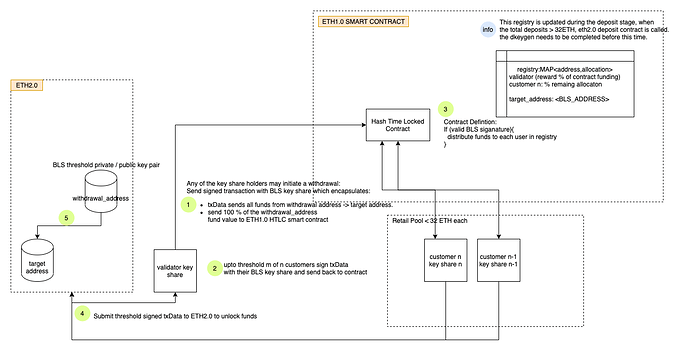Hello, I was brainstorming a trustless withdrawal process for pooled staking in eth2.0. Two things to note:
- This may be useless if/when withdrawal_address can be set to a smart contract directly.
- The security model requires a threshold set of honest pooled nodes to operate (threshold was selected over multisig for potential key loss).
Furthermore, I understand the cost of many of the required ops (BLS verify onchain) may stray from making this pragmatic in which case this is purely an academic exercise.
At the moment I am focusing solely on the withdrawal process.
The Idea
- The withdrawal_address is set to a threshold BLS key where the key shards are distributed to the validator and n pool participants
-
When the withdrawal is initiated, the distributed key holder (DKH) generates a eth2.0 transaction moving funds from the shared withdrawal_address to a target_address controlled by the (DKH). The DKH signs this txData with its BLS key share.
-
The DKH submits the txData on eth1.0 HTLC smart contract and sets the value=eth2.0 withdrawal_amount
-
Since we use threshold BLS instead of multisig, m of n nodes in the pool sign txData and resubmit to HTLC. We require an honest majority to ensure that the submitted value >= the eth2.0 value

-
The HTLC contract defines the following condition:
if(txData == valid_bls_sig){
distribute funds to pool holders based on registry
} -
The DKH receives the fully signed txData and can execute on eth2.0 to send funds to targetAddress
Issues
- we use threshold instead of multisig to prevent a withholding attack (but cause other problems)
- sybil/collusion attack - would require multiple random sub-committee selection rounds to sign txData
Not discussed and needs more thought:
-
Distributed BLS KeyGen ceremony for shared withdrawal key
-
Validator “bond” to prevent malicious attestations
-
Trustless depositing (would likely extend from the HTLC smart contract acting as a registry and after accumulating > 32ETH calling the eth deposit contract and setting the initial withdrawal address once a set of nodes fund the contract. Of course the dkeygen between the pooled nodes needs to be performed prior to this event)
